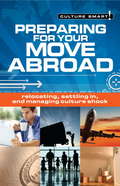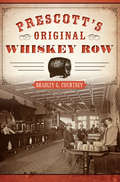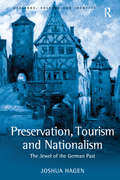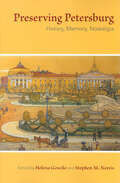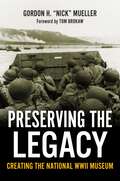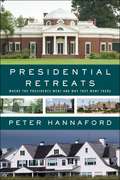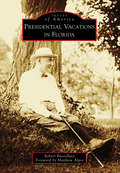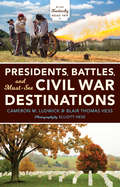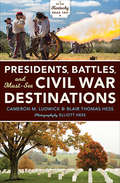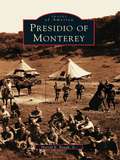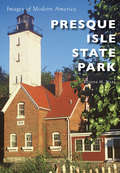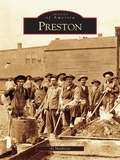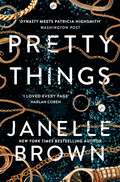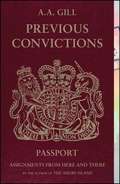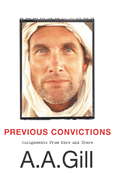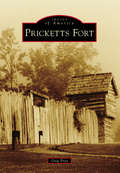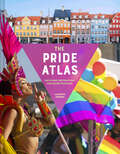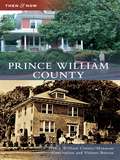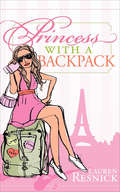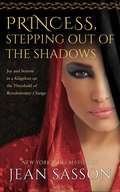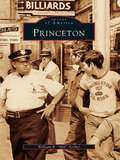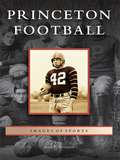- Table View
- List View
Preparing for Your Move Abroad
by Rona HartThis comprehensive, step-by-step guide is designed to prepare you for your move abroad and to enable you to manage the transition effectively. Alone in the market, it combines the practical, cultural, and psychological aspects of relocation, and helps to allay the fears and reduce the stresses that accompany this major event in a person’s life. Preparing For Your Move Abroadfollows a typical relocation timeline, taking you from your first step – the decision to move – to your integration into the host society, and through every step between these two points. Uniquely it offers: * A strong knowledge base for every stage of the relocation journey * A strategy to manage the issues at hand * Psychological preparation * An action plan, presented through exercises, practical steps to consider, checklists, and many easy-to-use tools It deals with the challenge of change by pulling together the practical, cultural, and psychological aspects of relocation and addressing them at each phase of the process. This distinctive approach helps you to develop three essential skills: systematic organization, cultural flexibility, and psychological resilience. These skills are crucial for successful change management, and can be put to use in any new culture, anywhere in the world. Moving to a new society invariably induces a degree of culture shock – largely the result of “change overload. ”Preparing For Your Move Abroadpresents a tried and tested strategy to help you manage the experience and quickly recover. No other book addresses this phenomenon, or attempts to help readers develop the skills to cope with it. The book aims to turn the challenges of relocation into opportunities for growth. By equipping you with essential knowledge, tools, and skills, it will help you to anticipate what lies ahead, address the challenges presented by your move with clarity and confidence, and make your transition successful, stress-free, and much more enjoyable.
Prescott’s Original Whiskey Row
by Bradley G. CourtneySome of the oldest, most notorious saloons in the American West lined the streets of Prescott's Whiskey Row. Dating back to 1864, the remote mountain town thrived on its mining and cattle industries during the day and raised hell at night when dusty outlaws and pioneers like Virgil Earp and Doc Holliday crowded Row saloons to quench their thirsts. Whiskey Row bore witness to legendary gunfights, murders and other curious tales, like that of Baby Bell, aka Chance Cobweb Hall, known today as Arizona's most famous saloon story. From crooked gambling operations and barroom brawls to the devastating fire of 1900, author and historian Bradley G. Courtney explores the colorful stories of Whiskey Row.
Preservation, Tourism and Nationalism: The Jewel of the German Past (Heritage, Culture and Identity)
by Joshua HagenSince its discovery by German romantics and nationalists, Rothenburg has been an established icon of the German nation and its medieval past. By tracing Rothenburg's historical development as a place of national importance, this book examines the cultural politics of historical preservation and tourism in general. In exploring the shifting practice and importance of tourism in Rothenburg and how this relates to broader debates about German culture and identity, Preservation, Tourism and Nationalism offers an important and original perspective on the changing dynamics of romanticized historical landscapes and how events are used to further national, cultural and political agendas. It also analyses the changing practices of historical preservation, and in particular, how historic preservation in Rothenburg reflects a desire to make it more historic and more German. With important insights into what it means to be German, how Germans relate to the past and how the answers to these questions have changed over time, this richly illustrated and detailed volume offers an important narrative of the rise, evolution and contestation of memory in German culture.
Preserving Petersburg: History, Memory, Nostalgia
by Helena Goscilo and Stephen M. Norris“Goscilo and Norris’ innovative anthology provides Slavic scholars with a panoramic view of the city’s literary, pictorial and social manifestations.” —Europe-Asia StudiesFor more than three centuries, St. Petersburg, founded in 1703 by Peter the Great as Russia’s westward-oriented capital and as a visually stunning showcase of Russia’s imperial ambitions, has been the country’s most mythologized city. Like a museum piece, it has functioned as a site for preservation, a literal and imaginative place where Russians can commune with idealized pasts. Preserving Petersburg represents a significant departure from traditional representations. By moving beyond the “Petersburg text” created by canonized writers and artists, the contributors to this engrossing volume trace the ways in which St. Petersburg has become a “museum piece,” embodying history, nostalgia, and recourse to memories of the past. The essays in this attractively illustrated volume trace a process of preservation that stretches back nearly three centuries, as manifest in the works of noted historians, poets, novelists, artists, architects, filmmakers, and dramatists.“The collection truly sparkles as the contributors each in turn take up this snuff box of a city . . . and breathe movement and life into the idealized Petersburg museum.” —Gregory Stroud, Bennington College“This collection brings together history, literature, architecture, and the politics of memory.” —Choice“An interesting and important contribution to existing scholarship on St. Petersburg’s myth, cult, and text . . . this volume is distinctive.” —Catharine Theimer Nepomnyashchy, Columbia University“A truly innovative contribution to the scholarship on Petersburg . . . The volume should be read by all serious Slavic scholars.” —Emily Johnson, University of Oklahoma
Preserving the Legacy: Creating The National WWII Museum
by Gordon H. MuellerPreserving the Legacy offers a comprehensive and compelling look at the founding and first two decades of The National WWII Museum, now one of the largest and most immersive military museums in the United States. Before its inception, friends and historians Gordon H. “Nick” Mueller and Stephen E. Ambrose recognized the need for an institution dedicated to preserving the oral histories of WWII veterans and the history of World War II more generally. Their efforts resulted in the opening of the D-Day Museum on June 6, 2000.With funding from the federal government, the state of Louisiana, and numerous individuals—including actor Tom Hanks and director Steven Spielberg—the Museum rapidly expanded. Following Ambrose’s death in 2002, the U.S. Congress designated the institution as “America’s National World War II Museum.” Today it consists of seven separate pavilions that span the entirety of the war and boasts several multifaceted educational programs, many of which are held in the Museum’s Higgins Hotel and Conference Center. Its twenty-five-year history is one of remarkable success.Preserving the Legacy begins with a foreword by famed journalist and longtime champion of the Museum Tom Brokaw. Nick Mueller then narrates the growth of the Museum, detailing its leadership and the various intellectual challenges involved in accurately portraying the scale of wartime sacrifice and loss. He traces the development, deliberations, and decisions of the many boards and committees that helped transform the embryonic institution into a sprawling museum complex in the heart of New Orleans. Far surpassing the modest intentions of its founders, The National WWII Museum not only provides today’s visitors with authentic historical context but also will serve as a valuable educational resource for generations to come.
Presidential Retreats
by Peter HannafordWhere do you go to relax when you're the leader of the free world? Even the president needs to get away from it all sometimes. From George Washington to Barack Obama, each of our presidents has sought solace from the tightly structured daily routines of the White House. As Ronald Reagan once said of his California ranch, "I do some of my best thinking there." Peter Hannaford takes readers on a fascinating armchair vacation with each of our leaders, offering unique historical context for the why and the where of their chosen retreats. Which president asked visiting foreign dignitaries to send him seeds to plant at his family home? Who called his vacation property "Sherwood Forest" because it was "a good place for an outlaw"? Which adventure-loving Commander-in- Chief set up a Summer White House in New York every year? Who liked to cruise aboard the presidential yacht when faced with momentous wartime decisions? Who polled the American people to help him decide where to vacation? Presidential Retreats explores a side of the American presidency that we don't often see--the downtime--as it offers an intriguing glimpse at the evolution of leisure time in this country.
Presidential Retreats: Where the Presidents Went and Why They Went There
by Peter HannafordA fascinating history of U.S. presidential vacation spots--collected for the first time in one guide that covers everything from Mount Vernon to Kennebunkport to Camp David.Where do you go to relax when you're the leader of the free world? Even the president needs to get away from it all sometimes. From George Washington to Barack Obama, each of our presidents has sought solace from the tightly structured daily routines of the White House. As Ronald Reagan once said of his California ranch, "I do some of my best thinking there." Peter Hannaford takes readers on a fascinating armchair vacation with each of our leaders, offering unique historical context for the why and the where of their chosen retreats. Which president asked visiting foreign dignitaries to send him seeds to plant at his family home? Who called his vacation property "Sherwood Forest" because it was "a good place for an outlaw"? Which adventure-loving Commander-in- Chief set up a Summer White House in New York every year? Who liked to cruise aboard the presidential yacht when faced with momentous wartime decisions? Who polled the American people to help him decide where to vacation? Presidential Retreats explores a side of the American presidency that we don't often see--the downtime--as it offers an intriguing glimpse at the evolution of leisure time in this country.
Presidential Vacations in Florida (Images of America)
by Robert BuccellatoAbe Lincoln did not split rails in Tampa, and George Washington's cherry tree might not have been cut in Miami-Dade, but in Key West, the famous Harry S. Truman sign--"The Buck Stops Here"--still resides on the former president's Florida White House desk. A few hours north is the Kennedy bunker, complete with the presidential seal painted on the concrete floor just in case the Soviets started a nuclear war while Kennedy was vacationing in Palm Beach. Florida may not have a presidential homestead, but it contains the Disney resort where an embattled Richard Nixon exclaimed "I am not a crook" and the fishing hole where Chester A. Arthur discovered that he would not live to see a second term. It is the place where presidents have come to escape and let down their guards. For generations, the Sunshine State has turned commanders in chief into relaxed tourists, allowing them to juggle the formal functions of the office while reconnecting with their private lives. Illustrated with rare and candid photographs, Presidential Vacations in Florida is a book for any lover of the American presidency.
Presidents, Battles, and Must-See Civil War Destinations: Exploring a Kentucky Divided
by Blair Thomas Hess Cameron M. Ludwick Elliott HessAs a border state and strategic territory, Kentucky was fiercely contested by the Union and the Confederacy and had ties to both Abraham Lincoln and Jefferson Davis. Kentucky natives and adventure aficionados Cameron M. Ludwick and Blair Thomas Hess plot the course for a fun-filled road trip through history and across the Bluegrass State in Presidents, Battles, and Must-See Civil War Destinations. Ludwick and Hess make planning a trip to historic Kentucky easy by exploring the history and stories behind each major site and highlighting nearby attractions you won't want to miss. Featuring step-by-step guidelines and exclusive tips on sites, monuments, and attractions from presidential homes to the best modern re-enactments, Presidents, Battles, and Must-See Civil War Destinations helps the whole family experience and enjoy history together.
Presidents, Battles, and Must-See Civil War Destinations: Exploring a Kentucky Divided (My Old Kentucky Road Trip)
by Blair Thomas Hess Cameron M. LudwickTake a historical tour through the Bluegrass State, with fascinating facts, photos, and tips for travelers. As a border state and strategic territory, Kentucky was fiercely contested by the Union and the Confederacy and had ties to both Abraham Lincoln and Jefferson Davis. This book guides you to the sites of such battles as Perryville, Middle Creek, and Munfordville, and the childhood homes of both Lincoln and Davis as well as Mary Todd. You&’ll also learn about Kentucky&’s Confederate capital, Civil War governors, and its African American soldiers. Kentucky natives and adventure aficionados Cameron M. Ludwick and Blair Thomas Hess plot the course for a fun-filled road trip through history and across the Bluegrass State in Presidents, Battles, and Must-See Civil War Destinations.
Presidio of Monterey (Images of America)
by Harold E. Raugh Jr.The Presidio of Monterey is best known as the home of the post-World War II Defense Language Institute Foreign Language Center, the Department of Defense's acknowledged leader in foreign language training. It has, however, a much longer and rich history. After the United States seized Monterey in 1846, the U.S. Army began constructing Fort Mervine, which served a number of purposes until it was abandoned in 1866. In 1902-1903, a modern cantonment was built in the area. In 1904, the new post was officially renamed the Presidio of Monterey after a nearby Spanish fort established in 1770 that had fallen into disuse. Throughout the first half of the 20th century, the post was home to infantry and cavalry regiments, as well as an inductee reception center. The Military Intelligence Service Language School was moved to the Presidio of Monterey in 1946 and renamed the Army Language School in 1947; this evolved into the present-day Defense Language Institute Foreign Language Center.
Presque Isle State Park (Images of Modern America)
by Eugene H. WareLocated on a seven-mile peninsula on the shores of Lake Erie in Erie, Pennsylvania, Presque Isle State Park attracts four million visitors each year. With its designation in 1921, Presque Isle became the second state park in Pennsylvania. From this beginning, the citizens of Erie and surrounding areas developed an affinity and appreciation for the park. Presque Isle hasbeen left relatively unchanged over the years, and when improvements have been made, they have been executed in ways that have not altered the park's natural beauty. Through images gathered from the collections of the author, Erie County Historical Society, Pennsylvania Department of Conservation and Natural Resources, and various other local sources, Presque Isle State Park reflects the history and unique atmosphere of a park that has come to be known as "a place for all seasons."
Preston
by Al MathisonNestled in a lush valley along the banks of the Root River, Preston, Minnesota, is ideally located at the geographic center of Fillmore County. The earliest settlers found the area rich with everything they needed to build a community: timber, building stone, water power, and fertile soils. By 1860, Preston was a bustling business and government center in the heart of the most populous county in Minnesota. With rare and vintage photographs culled from the collection of the Fillmore County History Center, as well as from the albums and scrapbooks of many local residents, this book brings together nearly 200 images of Preston and its environs.
Pretty Things
by Janelle BrownSOON TO BE A LIMITED SERIES STARRING NICOLE KIDMAN'Pretty Things is awesome. Simple as that. I loved every page'Harlan Coben'It's Dynasty meets Patricia Highsmith' Washington Post 'Will keep you turning pages till the end'Attica Locke 'Outrageously entertaining'Times Crime Club Nina once bought into the idea that her fancy arts degree would lead to a fulfilling career. When that dream crashed, she turned to stealing from rich kids in L.A. alongside her wily Irish boyfriend, Lachlan. But when her mom falls ill, Nina puts everything on the line to help her, running her most dangerous scam yet.Vanessa is a privileged young heiress who wanted to make her mark in the world. Instead she becomes an Instagram influencer - but behind the covetable façade is a life marked by tragedy.After a broken engagement, Vanessa retreats to her family's sprawling mountain estate, a mansion of dark secrets. It's there that her path collides with Nina's and gives way to a winter of desire and aspiration, duplicity and revenge.'Smart, seductive, and utterly captivating' PopSugar'Deliciously fun' The Week'A can't-look-away story of and for our generation' Chandler Baker, author of Whisper Network'Literary suspense at its best' Angie Kim, author of Miracle Creek
Previous Convictions
by A. A. GillCritic, essayist and cultural savant A. A. Gill is probably the most widely read columnist in Britain. His books The Angry Island and A. A. Gill is away have found delighted fans in America as well, and sparked a loyal following. His new book of travel essays, Previous Convictions, ranges from Gill's nearby domestic locales of Glastonbury and the English countryside to Haiti, Guatemala, Pakistan and exotic, dangerous, downtown Manhattan. In this collection of notes from the corners of the globe, and sometimes from the edge of sanity, he confesses about his travels far and wide, "The more I see of the world, the less I think I understand. Familiarity breeds even more astonishment. The world just gets wider and deeper and weirder. "These pieces are wickedly funny, sometimes pointedly -- even purposely -- critical of many cultures and traditions, and always edifying and enchanting. As an adventurer and as a writer, Gill never disappoints; while he may take others to task for their customs, habits, idiosyncrasies and plain bad taste, his own indefatigable curiosity keeps him going back again and again for more, and provides us with spectacular entertainment along the way.
Previous Convictions: Assignments From Here and There
by Adrian GillThe second collection of travel writing (and other essays) by Britain's funniest and most feared critic.A.A. Gill is probably the most read columnist in Britain. Every weekend he entertains readers of the Sunday Times with his biting observations on television and his unsparing, deeply knowledgeable restaurant reviews. Even those who want to hate him agree: A. A. Gill is hopelessly, painfully funny. He is one of a tiny band of must-read journalists and it is always a disappointment when the words 'A. A. Gill is Away' appear at the foot of his column. This second book is a further collection of those absences; 22 travel pieces and essays on other subjects that belie his reputation as a mere style journalist and master of vitriol. This is writing of the highest quality and ambition.
Previous Convictions: Assignments From Here and There
by Adrian GillThe second collection of travel writing (and other essays) by Britain's funniest and most feared critic.A.A. Gill is probably the most read columnist in Britain. Every weekend he entertains readers of the Sunday Times with his biting observations on television and his unsparing, deeply knowledgeable restaurant reviews. Even those who want to hate him agree: A. A. Gill is hopelessly, painfully funny. He is one of a tiny band of must-read journalists and it is always a disappointment when the words 'A. A. Gill is Away' appear at the foot of his column. This second book is a further collection of those absences; 22 travel pieces and essays on other subjects that belie his reputation as a mere style journalist and master of vitriol. This is writing of the highest quality and ambition.
Pricketts Fort (Images of America)
by Greg BrayPricketts Fort was built on the land of Jacob Prickett in 1774, during what is known as Lord Dunmore's War. It provided sanctuary for local settlers before and during the American Revolution and was a safe haven from the attacks of American Indians until the Battle of Fallen Timbers in 1794. Constructed by local militia on a small rise near the confluence of Pricketts Creek and the Monongahela River, Pricketts Fort provided refuge for approximately 80 families. The fort itself was large by 18th-century standards. It had blockhouses at each corner, with walls 12 feet high and 110 feet long. Although the fort was never attacked, many outlying homes were, and a number of settlers lost their lives. Today, Pricketts Fort hosts visitors looking to learn more about day-to-day life on the western Virginian frontier.
Pride Atlas: 500 Iconic Destinations for Queer Travelers
by Maartje HensenCombining immersive photography with expertly researched travel writing, this is the ultimate guidebook for LGBTQ+ travelers—whether you're planning your next getaway, daydreaming from the comfort of your armchair, or seeking to learn about queer culture in other parts of the world.This swoon-worthy guide to the best places and events the queer world has to offer spans the globe, taking you from metropolitan must-sees, like the birthplace of Pride in New York or the world's first gayborhood in Berlin, to lesser-known gems, like a trans designer's clothing store in São Paulo or the first LGBTQ+ bar in Nepal.Maartje Hensen and a diverse team of international travel writers have put together information on the best drag shows, Pride parades, and film festivals all around the world, as well as resources regarding laws, restrictions, and cultural attitudes—ensuring that travelers can safely enjoy their sojourns and find community wherever they go. Whether you're looking for relaxation, romance, or adventure, The Pride Atlas will help you plan your next gaycation.SERIOUS EYE CANDY: Bursting at the seams with full-color photographs, The Pride Atlas is a colorful addition to any bookshelf or coffee table. It offers an immersive, take-me-there reading experience, as well as the nuts-and-bolts practical information that will transform armchair travel into actual trip planning.INCLUSIVE AND INFORMATIVE: Whether you are a drag show fanatic, a gay couple in search of international community, an ally planning an ethical and informed vacation, or a cohort of queers looking for a good time—this is the travel book for you. With information on both festivities for and frustrations facing queer travelers, written by a diverse team of LGBTQ+ travel bloggers, The Pride Atlas is a unique and valuable resource.Perfect for:LGBTQ+ vacation planners and armchair travelersInformed, ethical travelers who want to know about LGBTQ+ rights and culture in the places they visitA practical and inspiring birthday, graduation, wedding, bon voyage, or special occasion gift for all who love to explore
Primate Tourism
by Anne E. Russon Janette WallisPrimate tourism is a growing phenomenon, with increasing pressure coming from several directions: the private sector, governments, and conservation agencies. At the same time, some primate sites are working to exclude or severely restrict tourism because of problems that have developed as a result. Indeed, tourism has proven costly to primates due to factors such as disease, stress, social disruption, vulnerability to poachers, and interference with rehabilitation and reintroduction. Bringing together interdisciplinary expertise in wildlife/nature tourism and primatology, experts present and discuss their accumulated experience from individual primate sites open to tourists, formal studies of primate-focused tourism, and trends in nature and wildlife tourism. Chapters offer species- and site-specific assessments, weighing conservation benefits against costs, and suggesting strategies for the development of informed guidelines for ongoing and future primate tourism ventures. Primate Tourism has been written for primatologists, conservationists and other scientists. It is also relevant to tourists and tourism professionals.
Prince William County
by Prince William County/Manassas Convention and Visitors BureauPrince William County, just south of Washington, D.C., has changed dramatically over the years. The area welcomes thousands of visitors annually to historic sites and is home to thousands more residents. This volume takes readers on a journey through the county that preserves its past with an eye to the future.
Princess with a Backpack
by Lauren ResnickA fun guide for the adventurous female traveler! With quotes, practical advice, and anecdotes from popular personalities, this travel guide helps princesses who want to leave their castles, see the world, and experience true adventure. Put on that backpack (even if it clashes with your cute outfit) and find out: How to plan your trip (without freaking out)What to wear for both comfort and styleHow to pack—for more than six months of travel timeHow to keep trim and still eat pizza in RomeEurope&’s best bars, parties, clothing stores, and accommodations—fit for a princess (all tried, tested and approved)—and more!
Princess: Stories of Joy and Sorrow in a Kingdom on the Threshold of Revolutionary Change (Princess Trilogy #Bk. 1)
by Jean SassonSome things never change—even in the life of a Saudi Princess! Whether it is entertaining guests in her decadent palace, jet-setting between four mansions on three different continents, or receiving opulent jewels from her adoring husband, the royal lifestyle is nothing new to Princess Sultana Al Sa’ud. And neither are the antics of the Royal Family: from a niece who constantly steals from her to a sister obsessed with having the lips of Angelina Jolie. And of course there’s Sultana’s bullish brother who is convinced that her outspokenness will be the ruin of the Royal Family! But miraculous change is also in the air. The young Saudi Crowned Prince has proclaimed his plan to give Saudi women more freedoms, including the right to drive! Princess Sultana exults as her beloved Kingdom moves further away from the days of infant girls buried in sand and women battered by stones or the fists of their husbands. Even as a bright, new day lingers on the horizon, Saudi women’s biggest obstacle still lurks in the shadows—the Guardianship Law. Will Saudi Arabia forever be plagued with men who doubt women’s capacity to make their own decisions? Will the winds of change wither to a whisper? Whatever may occur, Princess, Stepping Out of the Shadows proves that nothing is simple in Saudi Arabia.
Princeton
by William R. ArcherThroughout its existence, Princeton has been a community at a unique three-way intersection connecting the heart of the Allegheny Mountain range with the fertile Valley of the Virginias to the east and the Cumberland Gap to the west. In 1837, the Virginia General Assembly formed Mercer County, named in memory of Revolutionary War general Hugh Mercer; at the same time, the county's seat was named in honor of the Battle of Princeton, New Jersey, the 1777 battle in which General Mercer died. Twenty-five years after the county's formation, retreating Confederate soldiers burned the homes of the town of Princeton to the ground. The coming of the Virginian Railroad in the first decade of the 20th century and the construction of the West Virginia Turnpike 40 years later transformed Princeton from a remote rural outpost into a vibrant center of commerce and ultimately led to the evolution of Princeton into a true crossroads for the region.
Princeton Football (Images of Sports)
by Mark F. BernsteinPrinceton played the first intercollegiate football game in 1869 and, since then, has gone on to win 28 national championships and nine Ivy League titles. Over the last 140 years, Princeton's Tigers have produced a Heisman Trophy winner, scores of All-Americans, and some of the game's greatest legends. From soldier of fortune Johnny Poe to tragic hero Hobey Baker to Charlie Gogolak, one of the first soccer-style kickers, Princeton Football captures the players, coaches, games, and stadiums that have made the Tigers one of the most storied programs in all of college football.
